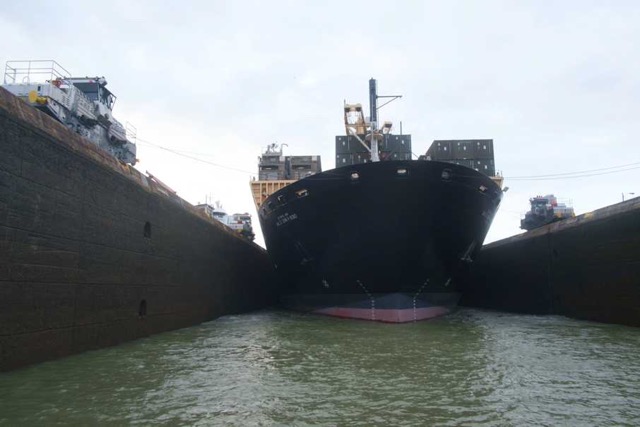The Point of No Return?

Vega
Hugh and Annie
Sat 11 Mar 2017 20:19
| Fo us transiting the Panama Canal represents a Significant Event. Not only does it get you from Atlantic to Pacific oceans it also moves you into a very different weather system - the Caribbean side of Panama is windy and the Pacific side windless. As we crossed the Gatun Lake and then emerged through the Miraflores Locks into the Pacific it felt like we were moving into a new and more remote stage of our circumnavigation. Although yachts go through the canal in both directions it is not like the Caribbean where you can keep going north and then east back to the Atlantic and home. We are now past the point of no return and can only continue on to the Galapagos, the South Pacific islands and beyond. We did a practice run through the canal as line handlers for Little Dove a few days before Vega was due to transit, and although it is not much different in principle to the canal locks back home everything is of course on a much grander scale. You are also likely to be rafted up to other yachts and dependent upon the advisor in the middle boat to oversee things. Our advisors with both Little Dove and Vega were all very amiable and helpful. When asked if they had done the transit before they would give a wry smile but seemed receptive to our offer of advice should they ever require it! One of our advisors said he had given up counting five years ago when his tally reached 500 times. A sure fire ice breaker was to ask them about their families and out would come the mobile phone with pictures of wife, children and so-on. The advisors have other full time jobs, usually associated with the canal, and do the transit with yachts for extra cash in their spare time. It was great to see that some had been able to pick up the web cam pictures of us in the lock and it looks like the AIS is still performing even if the indicated route of our transit was in parallel with the canal on the chart! Our final two nights on the mainland were at the Balboa Yacht Club just outside Panama City where we picked up a mooring buoy. There was good wifi at a nearby hotel, and a great fruit and vegetable market and a chart shop both 10 minutes away by taxi. Panama City in the background looks like a pretty vibrant collection of modern high rise buildings but we chose to concentrate upon provisioning, fuelling and wifi rather than visit the bright lights. Las Perlas Islands are not rated as highly as the San Blas islands but in fact turn out to be a wonderful cruising area with forest, mangrove, beautiful sandy beaches and secluded anchorages. The water at this time of year is not very clear but seems to be teeming with small fish given the hundreds of pelicans and cormorants we see everywhere. There are similar islands all along the Panamanian coast on the Pacific side and later in the year big migrations of whales that you can swim with according to a young French couple we met in one anchorage. The big issue now is fuel. It is 850 miles to the Galapagos and given that there is no wind there is likely to be a limit to the amount of time we can afford drifting along at 1 knot. We have Tom from Bristol on board with us who has a return flight from the Galapagos on 27th March and his wife is flying out on the18th! A full tank for us is 250 litres which is enough for about 600 miles. I can see now why other yachts have so many spare fuel containers on board. We topped up our tank with the 20 litres we keep in reserve last night before discovering, despite the confident assurances of the young boys who paddled out to meet us, that there was no diesel to replenish it in Esmeralda Village, our last stopping point in Panama on the Isla del Rey. So we just have to hope that the forecast wind over the weekend en route to Galapagos actually materialises or Tom may have to be as flexible on his timescales as he is claiming to be! We are motoring to the south west as I write……………..          |